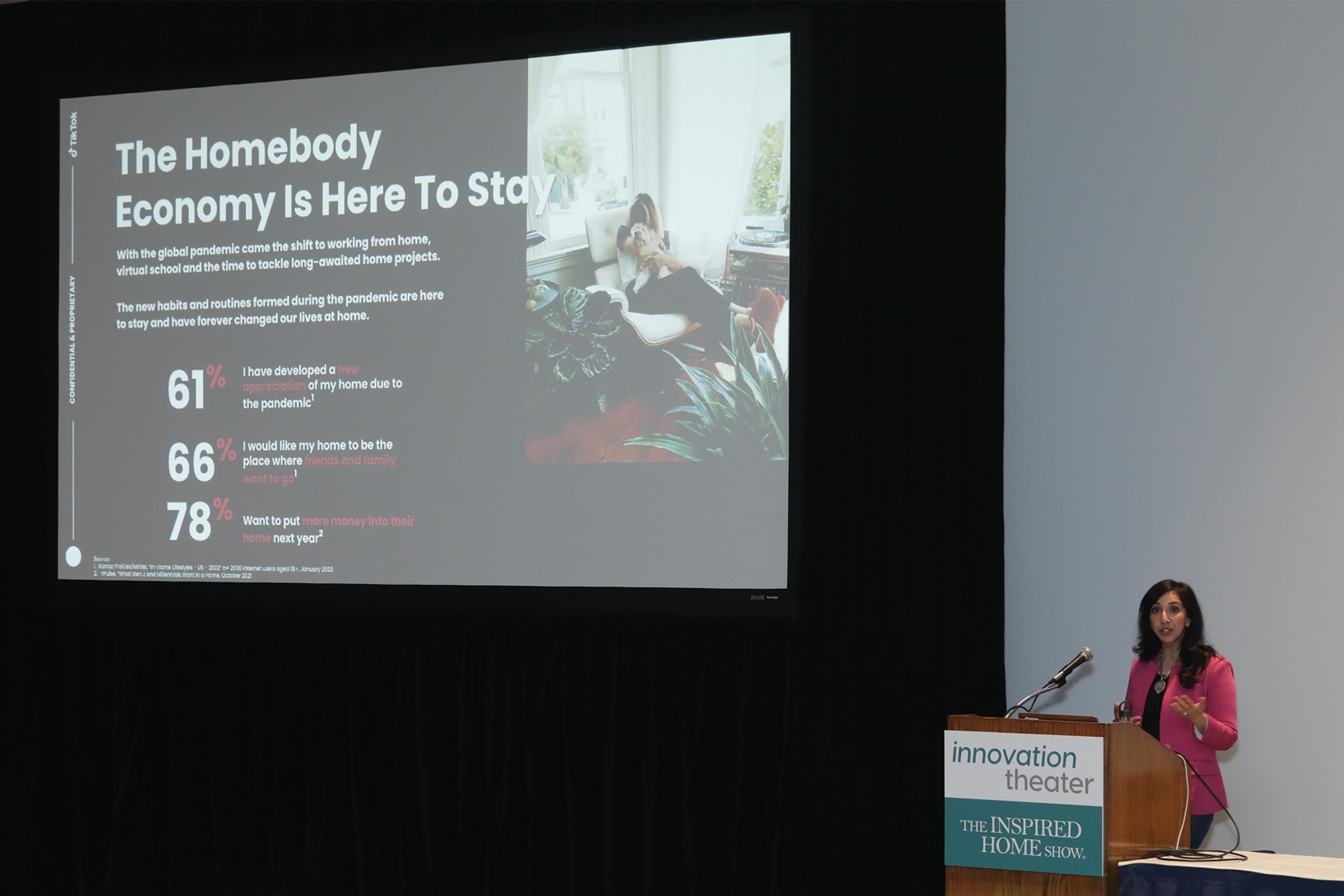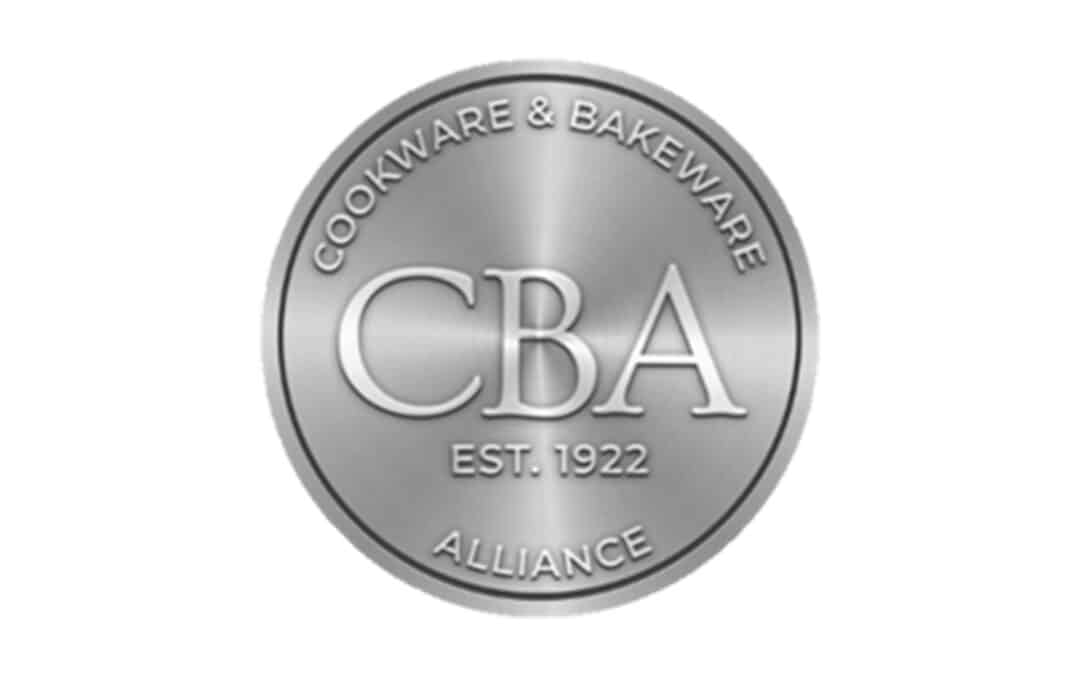Change and how to cope with it now and into the future was the overriding theme at the Saturday Innovation Theater sessions at The Inspired Home Show.
Discovery to Purchase in a Digital World
Anita Desai, TikTok
Anita Desai, head of industry, home and living for TikTok made the point that introducing and maintaining sales of products has added a new dimension to social media where, in more cases now than ever, engaging consumers requires entertaining them. Consumers who are interested in authenticity want to connect with culture and communities. Indeed, she said, with TikTok, community has become akin to demographics in that learning about and addressing the concern of a group of people who are bound by common interests and preferences is the first step in reaching them.
She said behaviors that people learned in the COVID-19 pandemic, when consumers increasingly embraced video and the creators who made them, haven’t faded. At the same time, consumers upgraded their homes and continue to value them in part for the changes they made to support lifestyles that evolved during the pandemic.
“We have all gone through that shift of working from home, kids in virtual schools and spending time in our homes, getting reacquainted with our homes, loving our homes, upgrading our homes,” Desai said. “We found that these new habits that people started to learn in the pandemic have stayed and grown and become part of how they live lives today. We’ve seen that 61% of folks on TikTok have developed a new appreciation of their homes coming out of the pandemic. Sixty-six percent have a home they want to be a place where their friends and family want to go. And nearly 80% of the people want to put more money in their homes next year.”
Frequent TikTok users, Millennials are now heading up households, bought the most homes in 2021 and account for the largest share of homes with kids at 46%. Then, Millennials are fast-tracking lifestyles with, for example, one in three getting married this year. Four keys Desai said businesses should think about when addressing Millennials are, first, making it easy for them because they have a lot going on and so favor products with clear benefits in a superior shopping experience; authenticity remains critical for maintaining contact with consumers who want what they feel are real connections; addressing their wellness concerns in an open and positive way is important, and in their broad sense of wellness including body, community and home; and finally, Millennials want to do things with purpose, including purchasing for their home, and they lack brand loyalty. They do, however, identify with companies that take a stand on issues they care about.
Desai said TikTok users embrace the social media platform because they favor the entertaining approach to a variety of subjects. They like it when brands reach out to the TikTok communities in which they participate in a way that demonstrates affinity. And, she added, 76% of people on the platform love how innovative creators get with home products on the site. What they seek includes point-of-view videos on tasks such as cleaning, reviews, home inspiration, satisfaction in use, and quick hacks and tips. She said 71% of users said that TikTok taught them something they didn’t know about home products.
2024 Householder Trends
Kate Usher, TrendBible
Kate Usher, senior trend consultant at TrendBible, said that the trend forecasting her company does is based on life at home. The company explores megatrends that cycle through many years, such as sustainability and the digital age. Then, the company looks at macrotrends that go into greater detail in a way that is more tangible and useful, especially those planning new products, projects and marketing initiatives.
Based on those macrotrends, TrendBible considers details.
“How does a macrotrend manifest itself into design, product development and by season?” she asked.
TrendBible sees four key consumer developments affecting the home sector including Democratizing Domesticity, the Hybridized Home, The Rise of Rental and Thinking Circular. Usher pointed out that Democratizing Domesticity touches on families becoming less nuclear and, in some cases, becoming more extended. However, she pointed out that 23% of children in the United States live in single-parent households. The Hybridized Home includes not only working from home but also a recognition that the household has changed in its form and function to accommodate new lifestyles, so shifting uses for living spaces and multifunctional products such as storage or bench ottomans have become more important. In just one example of family situations changing, 58% of young adults in the U.S… live with their parents. The Rise of Rental is occurring in an uncertain economy, with shifting lifestyles and reassessment of the value of renting versus home ownership, which is, anyway, out of reach for many consumers who are living in more urbanized settings. She said that three times as many people in their 30s and 40s are renting versus 20 years ago. Circular Thinking is occurring as consumers, especially younger ones, are moving beyond sustainability and supporting regenerative actions. So renting products their parents would have purchased and favoring products made from what otherwise be manufacturing waste have gained attention, as have biomaterials and products with unfinished looks. It also means cutting back on or looking for products made from materials of concern, and, Usher said, 87% of consumers express concern about plastic and packaging waste.
Usher said that figuring out how to respond to such trends is important but where to begin differs from retailer to retailer. TrendBible has a methodology that looks at where customers of a brand sit in a pyramid topped by consumers ready to take action, early adopters and those trailing on the issues even if they are concerned. Then, businesses have to assess, given what their customers are embracing, which trends they need to respond to depending on their brand positioning.
“You need to figure out where your customer sits on that pyramid of influence and that will help you determine how far forward you should be looking and planning,” she said. “And which trends you respond to depends on your brand DNA. We overlay your own brand story and identity with trends and make sure you are only responding to the trends that are relevant to you and have longevity for your business.”
Get Your Housewares in Order: Investing in KPIs for Success
Ranga Bodla, Oracle NetSuite; Hayden Wadsworth, HydroJug
In the session Get Your House in Order: Investing in Key Performance Indicators for Success, Ranga Bodla, vp field engagement and marketing, NetSuite Global Business Unit at Oracle, and Hayden Wadsworth, CEO of HydroJug, discussed identifying metrics that can help a company navigate market changes, whether based on internal dynamics or external influences such as the COVID-19 pandemic. Technology can provide a more holistic view of a business, which Bodla said, but he emphasized that the kind of tools, including those Oracle provides, shouldn’t be just considered in terms of financials but across a business operation. He said the broad view can give a business an understanding of when to make significant changes and then monitor those changes as they evolve. He said that establishing KPIs that cover sales, marketing and CRM, financials, order management, sourcing and warehousing, and production and manufacturing, can give businesses solid grounds for moving forward with plans.
Bodla said KPIs are useful tools as a business goes through its growth stages from when it has only a few SKIs to when it has to scale up and develop more sophisticated means to understand what’s going on in its operations. They also can help businesses understand when it would be a good idea to make a major change such as developing a new sales channel.
HydroJug started out with a single SKU then began to expand gradually adding insulated products, straws and sleeves to serve demand, Wadsworth said. Then, the company recognized it had to monitor product growth cycles and how to manage those. If product growth cycles aren’t properly managed then inventory can become problematic. Then, HydroJug experienced “massive” growth during the pandemic, Wadsworth said, as teachers, nurses, first responders and others who had to work but had no access to public water that had been shut down out of worry it might spread COVID. Then, coming out of the pandemic, HydroJug looked at the market and its indicators to come to a decision: to become truly omnichannel and move into physical retail in a big way. Now D2C will be about 70% of the business in 2023 and bricks and mortar 30%.
To do so required allocating resources and building processes that were repeatable and efficient and good for new retail customers, so HydroJug could “provide that same brand experience to them that we’ve provided direct-to-consumer.”
Bodla said the COVID-19 pandemic demonstrated that establishing and tracking KPIs can be a critical advantage as businesses have to shift in response to outside pressures. Just as it can help in the normal growth of a business, KPIs provided indications about measures to take including PPE loans. It also made clear what factors were critical to monitor.
“What we saw particularly was a real look at cash KPI, and free cash flow was one of the big ones,” Bodla said. “That one continues to be an important one as we’re in this mode of inflation, looking at how quickly that declines or changes. If you are overly reliant on one channel that metric can change overnight and force a change in the business.”
Wadsworth noted, “That one that’s top of the list for us, too. We have daily reporting that comes out on the financials. But starting right at the top, we’re paying close attention to gross revenue. Gross margin is also very big, especially when you’re opening up your channels. What is my gross margin? D2C should be higher than retail, and then how does that play out through the bottom line? It will determine how we invest in these channels and how we spend on marking. They’re great KPIs. Outbound shipping cost, we pay really close attention to as a percentage of gross revenue.”





